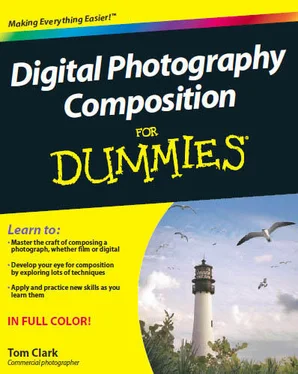compositional frame........183
Keeping a viewer in the frame........183
Choosing between the Horizontal and Vertical Formats...185
Understanding how your message influences
which format to use.........186
Determining format based on the subject......188
Letting the environment dictate format......190
Chapter 12: Exploring Other Compositional Ideas..193
Creating Harmony with Balance and a Sense of Scale....193
Keeping the elements balanced and properly weighted..194
Including a sense of scale.........197
Using Rhythm and Repetition of Elements.......200
Pulling harmony out of chaos........201
Shooting simple compositions.......202
Reinforcing your subject or intended message with repeating elements........204
Creative Ways to Break the Rules or Cheat the System...205
Experimenting with the tilt-shift lens......205
Taking multiple digital exposures.......208
Crafting soft, dream-like compositions.....210
Part IV: Composition In Action.... 213
Chapter 13: Showing People in Their Best Light...215
Showing a Person's Essence in Portraits......216
Capturing genuine expressions........216
Choosing your angle and your lens.......217
Adding interest by integrating your subject's hands
into the photo.........218
Taking advantage of a person's surroundings.....218
Getting Great Results from Both Candid and Posed Portraits..220
Making a case for candids........221
Taking control with posed shots.......222
Photographing People Together: Showing Connections....224
Overcoming the technical challenges of
photographing groups.........224
Composing portraits of couples......225
Setting up group portraits........226
Fabulous Darling, You're Gorgeous: Shooting Fashion Photography. 227
Chapter 14: In Nature: Landscapes and Wildlife...231
Recognizing Compositional Elements in Nature.....232
Expansive landscapes: Basking in your surroundings..232
Narrowing in on intimate landscapes.....234
Exploring fine detail through macro photography....236
Capturing Wildlife..........238
Finding animals to photograph........238
Getting the best-composed shot......239
Developing a Respect for Nature's Elements.....241
Photographing the Forest.........243
Determining what you want to photograph.....243
Factoring in light when in the forest.......243
Taking advantage of night in the forest......245
Chapter 15: Shooting Still-Life Photography...247
Making Everyday Objects Interesting.......248
Seeing objects as fine art........248
Selling objects with photography......249
Photographing Flowers in Studio and in Nature.....252
Producing images in the studio.......252
Capturing flowers in their natural environments....254
Cooking Up Beautiful Food Photos........255
Working with Architectural and Interior Photography....258
Crafting images of building exteriors......259
Taking a look inside: Composing interior shots....260
Chapter 16: Capturing (Or Stopping) Motion through Photography.....263
Following Compositional Principles When a Subject
Isn't Stationary.........264
Focusing on moving subjects.......264
Composing subjects in motion.......265
Deciding whether to freeze or show motion....266
Up for the Challenge: Photographing Subjects
Constantly on the Move..........273
Taking successful images of children.....273
Catching shots of the family pet......274
Tackling sporting events........275
Chapter 17: Artsy Photos: Fine Art, Composite Pictures, and Abstracts.......279
Classifying Photography as Fine Art.......280
Lighting your subject........281
Making the best of your situation......283
Composing Abstract Photos........284
Keeping the effects of color in mind......285
Using shapes and lines to create meaning.....285
Playing with tonality..........285
Putting it all together.........286
Combining Multiple Shots to Create a Single Photo.....287
Mimicking a made-up scene with multiple exposures..287
Creating collages..........289
Chapter 18: Improving Composition through Postproduction Editing.....293
Cleaning Up Your Composition.........294
Removing unwanted elements and flaws......294
Changing your perspective.......300
Editing Your Images to Draw the Viewer to Your Subject...304
Adjusting contrast in the scene using Curves Layers...304
Enhancing an image's light.......305
Sharpening your photos.........306
Part V: The Part of Tens ...... 309
Chapter 19: Ten Ways to Improve Composition..311
Reveal Contrast with Complementary Colors.....311
Harmonize with Monochromatic Colors......312
Make a Subtle Statement with Analogous Colors....312
Use a Shallow Depth of Field to Tell a Story......313
Shoot Until You've Exhausted the Possibilities.....313
Choose a Background That Says Something......314
Tackle Transparent and Reflective Elements......314
Treat Light as the Subject..........315
Incorporate a Compositional Frame.......315
Create a Composite Image..........316
Chapter 20: Ten Tips for Finding Photographic Inspiration..317
Take a Walk, Take Photos, and Take Notes.....317
Try Something Completely New........318
Emulate Your Favorite Shots by Other Photographers....319
Watch a Good Movie...........320
Visit a Museum...........320
Compile a Wall of Inspiration.........321
Purchase a New Lens..........321
Head Out for a Nighttime Photo Shoot.......321
Reveal the Lapse of Time in a Scene.......323
Join a Photography Forum.........323
Chapter 21: Viewing Ten Compositions of One Scene..325
Choosing a High Angle to Show the Scene.......325
Selecting a Low Angle to Emphasize the Subject....326
Highlighting the Subject and the Scene with a Wide-Angle Lens..327
Showing More Scenery with a Wide-Angle Lens......328
Narrowing In on Your Subject with a Long Lens.....329
Creating an Intimate Portrait by Using a Long Lens.....330
Paying Attention to the Foreground Elements in Your Scene...331
Giving Your Photo a Compositional Frame......332
Finding Negative Space.........333
Backlighting Your Subject to Emphasize Shape......334
Index ......... 335
If you want to create interesting and aesthetically pleasing photographs, you need to understand great composition. You have rules (which can, of course, be broken) to guide you, decisions to make, and techniques and tools to get the job done. Put all these together, and you give purpose and meaning to your photographs.
After you realize why some photographs look better than others and more successfully tell their stories, you can create amazing images wherever you are and in any conditions. You can approach any scene in many ways, and each photographer will do so differently. You want to be sure that you approach a scene with the confidence of a person who understands how to compose great images — and has fun doing so.
Whether you're an amateur, pro, semi pro, hobbyist, scrap booker, traveler, artist, or someone who just received a camera as a gift, knowing more about composition will make your photographs better. Besides, if you're going to take pictures, they may as well be good ones.
Contentions Used in This Book
In this book, I use the following conventions to make sure the text is consistent and easy to understand:
Читать дальше
Конец ознакомительного отрывка
Купить книгу












